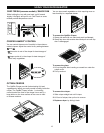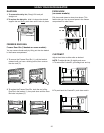
STORING FROZEN FOOD
NOTE: For further information about preparing food for
freezing or food storage times, check a freezer guide or
reliable cookbook.
Packaging
Successful freezing depends on the correct packaging.
When you close and seal the package, it must not allow
air or moisture in or out. If you do, you could have food
odor and taste transfer throughout the refrigerator, and
also dry out frozen food.
Packaging recommendations:
Rigid plastic containers with tight-fitting lids
Straight-sided canning/freezing jars
Heavy-duty aluminum foil
Plastic-coated paper
Non-permeable plastic wraps
Specified freezer-grade self-sealing plastic bags
Follow package or container instructions for proper
freezing methods.
Freezing
Your freezer will not quick-freeze any large quantity of
food. Do not put more unfrozen food into the freezer than
will freeze within 24 hours (no more than 2 to 3 lbs of food
per cubic foot [907-1350 g per liter] of freezer space).
Leave enough space in the freezer for air to circulate
around packages. Be careful to leave enough room at
the front so the door can close tightly.
Storage times will vary according to the quality and type
of food, the type of packaging or wrap used (airtight and
moisture-proof) and the storage temperature. Ice crystals
inside a sealed package are normal. This simply means
that moisture in the food and air inside the package have
condensed, creating ice crystals.
NOTE: Allow hot foods to cool at room temperature for
30 minutes, then package and freeze. Cooling hot foods
before freezing saves energy.
NOTE: Do not store food near the sensor; it may cause
the sensor to malfunction.
USING YOUR REFRIGERATOR
WARNING
Suffocation Hazard
When using dry ice, provide adequate ventilation.
Dry ice is frozen carbon dioxide (CO )
2
. When it
vaporizes, it can displace oxygen, causing dizziness,
light-headedness, unconsciousness and death by
suffocation. Open a window and do not breathe
the vapors.
Do not use:
Bread wrappers
Non-polyethylene plastic containers
Containers without tight lids
Wax paper or wax-coated freezer wrap
Thin, semi-permeable wrap
16
FOOD STORAGE GUIDE
Storing Fresh Food
Wrap or store food in the refrigerator in airtight and
moisture-proof material unless otherwise noted. This
prevents food odor and taste transfer throughout the
refrigerator. For dated products, check code date to
ensure freshness.
Butter or margarine
Keep opened butter in a covered dish or closed
compartment. When storing an extra supply, wrap
in freezer packaging and freeze.
Cheese
Store in the original wrapping until you are ready to
use it. Once opened, rewrap tightly in plastic wrap or
aluminum foil.
Milk
Wipe milk cartons. For best storage, place milk on interior
shelf, not on door shelf.
Eggs
Store in original carton on interior shelf, not on door shelf.
Fruit
Wash, let dry, and store in refrigerator in plastic bags or
crisper. Do not wash or hull berries until they are ready
to use. Sort and keep berries in original container in a
crisper, or store in a loosely closed paper bag on a
refrigerator shelf.
Leafy vegetables
Remove store wrapping and trim or tear off bruised and
discolored areas. Wash in cold water and drain. Place in
plastic bag or plastic container and store in crisper.
Vegetables with skins (carrots, peppers)
Place in plastic bags or plastic container and store
in crisper.
Fish
Use fresh fish and shellfish the same day purchased.
Meat
Store most meat in original wrapping as long as it is
airtight and moisture-proof. Rewrap if necessary. See the
following chart for storage times. When storing meat
longer than the times given, freeze the meat.
Chicken ........................................................... 1-2 days
Ground beef .................................................... 1-2 days
Organ meats (liver, heart, etc.) ....................... 1-2 days
Cold cuts ......................................................... 3-5 days
Steaks/roasts .................................................. 3-5 days
Cured meats ...................................................7-10 days
Leftovers
Cover leftovers with plastic wrap or aluminum foil.


















